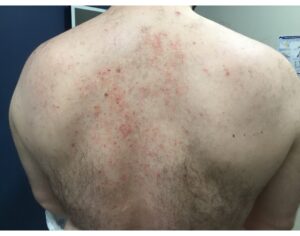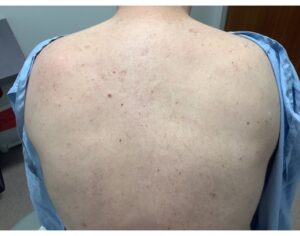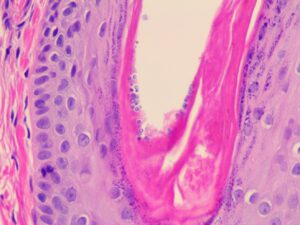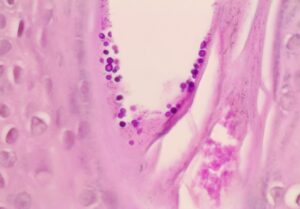Claire S Chung1, Beatriz Tapia-Centola2, Daniel S Loo3*
1Keck School of Medicine, University of Southern California, USA
2Quantum Pathology, Waltham MA, USA
3Tufts University School of Medicine and Boston VA Healthcare System, Boston MA, USA
*Correspondence author: Daniel S Loo, Tufts University School of Medicine and Boston VA Healthcare System, USA; Email: [email protected]
Published Date: 05-11-2024
Copyright© 2024 by Chung CS, et al. All rights reserved. This is an open access article distributed under the terms of the Creative Commons Attribution License, which permits unrestricted use, distribution, and reproduction in any medium, provided the original author and source are credited.
Letter to Editor
Pityrosporum Folliculitis (PF) is a condition characterized by pruritic 1-2 mm monomorphic follicular papules and pustules on the upper back, chest and shoulders. PF is caused by overgrowth of Malassezia furfur, a commensal yeast found in the infundibulum of sebaceous glands and may be exacerbated by immunosuppression, occlusion and sweating. We present a case of PF with inadequate response to both topical and systemic antifungal therapy, which completely cleared on isotretinoin.
A 44-year-old male with no significant medical history presented for evaluation of a pruritic rash on his chest and back which had been present intermittently for 2 years and was inadequately controlled with use of betamethasone valerate 0.1% cream and then ketoconazole 2% cream. Examination of the back revealed a large, slightly raised erythematous plaque with scale and scattered follicular papules and pustules (Fig. 1).
Potassium hydroxide preparation was negative for hyphae, pseudohyphae or spores. A subsequent biopsy taken from the upper back revealed spores in the follicular infundibulum consistent with PF (Fig. 3,4).
The patient was treated with fluconazole 300 mg once weekly for 8 weeks with little improvement. Due to failure of therapy with topical steroids and both topical and systemic antifungals, the patient began isotretinoin 60 mg daily for 1 month followed by 90 mg daily for 4 months (average 0.85 mg/kg/day). Aside from cheilitis and occasional blurry vision, the patient experienced no adverse effects. Four months after discontinuation of isotretinoin the patient remained clear (Fig. 2).
Topical and oral antifungal therapies are most commonly prescribed to target the overgrowth of Malassezia in PF. A review of the literature suggests that clearance of PF can be achieved by treating with oral itraconazole, ketoconazole or fluconazole [1-3]. Systemic antifungals are more effective than topical and the combination of topical and systemic antifungals is more effective than systemic monotherapy. Recurrence is common after treatment is completed and maintenance therapies such as weekly topical or monthly oral antifungals have been used as preventative measures.
We hypothesized that isotretinoin would be an effective alternative treatment to topical and systemic antifungal therapy due its known mechanism of shrinking sebaceous glands in which Malassezia are predominantly found. There are two reported cases of treating PF with isotretinoin. Friedman reported a 23-year-old female with biopsy-confirmed PF, who was treated with isotretinoin 0.65 mg/kg for 20 weeks with significant improvement [4]. However, PF recurred 10 months after discontinuation. Goodfield and Saihan reported a 35-year-old male with PF who failed to improve on isotretinoin therapy after minimal improvement and recurrence on antifungal therapies [5].
We present a case of a patient with PF who showed only partial improvement with topical and oral antifungal treatments. However, after a 5-month course of isotretinoin at 0.85 mg/kg per day, the patient achieved complete clearance, with no signs of recurrence 4 months later. This case demonstrates the efficacy of isotretinoin as a treatment option for patients with biopsy-confirmed PF who do not respond to systemic and topical antifungal therapies.

Figure 1: Erythematous papules before isotretinoin therapy.

Figure 2: Back is clear 4 months after isotretinoin was discontinued.

Figure 3: Basophilic Pityrosporum spores within a follicular infundibulum (20x).

Figure 4: Periodic acid Schiff stain highlights the presence of numerous Pityrosporum spores within a follicular infundibulum (20x).
Conflict of Interest
The authors declare they do not have conflicts of interest.
Funding Statement
The authors received no financial support for the publication of this article.
References
- Parsad D, Saini R, Negi KS. Short-term treatment of Pityrosporum folliculitis: a double blind placebo-controlled study. J Eur Acad Dermatol Venereol. 1998;11:188-90.
- Levy A, Feuilhade de CM, Dubertret l, Morel P, Flageul B. Malassezia folliculitis: characteristics and therapeutic response in 26 patients. Ann Dermatol Venereol. 2007;134:823-28.
- Rhie S, Turcios R, Buckley H, Suh B. Clinical features and treatment of Malassezia folliculitis with fluconazole in orthotopic heart transplant recipients. J Heart Lung Transplant. 2000;19:215-9
- Friedman SJ. Pityrosporum folliculitis: treatment with isotretinoin. J Am Acad Dermatol. 1987;16:632-3.
- Goodfield MJD, Saihan EM. Failure of isotretinoin therapy in Pityrosporum folliculitis. J Am Acad Dermatol. 1988;18:143.
Article Type
Letter to Editor
Publication History
Received Date: 14-10-2024
Accepted Date: 28-10-2024
Published Date: 05-11-2024
Copyright© 2024 by Chung CS, et al. All rights reserved. This is an open access article distributed under the terms of the Creative Commons Attribution License, which permits unrestricted use, distribution, and reproduction in any medium, provided the original author and source are credited.
Citation: Chung CS, et al. Successful Treatment of Pityrosporum Folliculitis with Isotretinoin. J Dermatol Res. 2024;5(3):1-4.

Figure 1: Erythematous papules before isotretinoin therapy.

Figure 2: Back is clear 4 months after isotretinoin was discontinued.

Figure 3: Basophilic Pityrosporum spores within a follicular infundibulum (20x).

Figure 4: Periodic acid Schiff stain highlights the presence of numerous Pityrosporum spores within a follicular infundibulum (20x).


